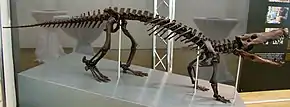Boverisuchus
Boverisuchus is an extinct genus of planocraniid crocodylian known from the middle Eocene (Lutetian stage) of Germany and possibly North America.[1] It grew to approximately three metres (10 ft) in length.

| Boverisuchus | |
|---|---|
 | |
| Restored B. magnifrons skeleton | |
| Scientific classification | |
| Kingdom: | Animalia |
| Phylum: | Chordata |
| Class: | Reptilia |
| Order: | Crocodilia |
| Family: | †Planocraniidae |
| Genus: | †Boverisuchus Kuhn, 1938 |
| Type species | |
| †Boverisuchus magnifrons Kuhn, 1938 | |
| Species | |
| |
| Synonyms | |
| |
History
The type species Boverisuchus magnifrons was first named by paleontologist Oskar Kuhn in 1938, from the Lutetian of Germany alongside Weigeltisuchus geiseltalensis. Most paleontologists have considered both species to represent junior synonyms of the type species of Pristichampsus, P. rollinatii. Following a revision of the genus Pristichampsus by Brochu (2013), P. rollinati was found to be based on insufficiently diagnostic material and therefore is a nomen dubium while Boverisuchus was reinstated as a valid genus. Brochu (2013) also assigned Crocodylus vorax, which has been referred to as Pristichampsus vorax since Langston (1975), as the second species of Boverisuchus. According to Brochu (2013), material from the middle Eocene of Italy and Texas may represent another yet unnamed species. The two Asian species of Planocrania were found to be most closely related to Boverisuchus using a phylogenetic analysis. The name Planocraniidae was reinstated to contain these genera and replace Pristichampsidae.[1]
Description and habits
Based on other planocraniids, Boverisuchus is assumed to have had heavily armoured skin, and long limbs suggesting a cursorial (i.e. running) habitus. It also had hoof-like toes, suggesting that it lived more on land than in the water, and that it therefore probably hunted terrestrial mammals.[2] The teeth of Boverisuchus were ziphodont; i.e., laterally compressed, sharp, and with serrated edges (characteristic of terrestrial crocodylians that are unable to dispatch their prey by drowning them). Due to their similarity to those of certain theropod dinosaurs they were initially mistaken for theropod teeth, leading paleontologists to believe that some non-avian dinosaurs survived the Cretaceous–Paleogene extinction event.[2]
Some material referred to Pristichampsus rollinatiii shows further features adapting the animal to this lifestyle. The tail was more reminiscent of a dinosaur's, being round in cross-section and lacking the osteoderm crest observed in extant crocodile species. It would also have been capable of galloping [3]
References
- Brochu, C. A. (2013). "Phylogenetic relationships of Palaeogene ziphodont eusuchians and the status of Pristichampsus Gervais, 1853". Earth and Environmental Science Transactions of the Royal Society of Edinburgh: 1. doi:10.1017/S1755691013000200.
- Palmer, D., ed. (1999). The Marshall Illustrated Encyclopedia of Dinosaurs and Prehistoric Animals. London: Marshall Editions. p. 101. ISBN 978-1-84028-152-1.
- Rossmann T. 2000. Studies on Cenozoic crocodiles: 5. Biomechanical investigation on the postcranial skeleton of the Palaeogene crocodile Pristichampsus rollinatii (Eusuchia: Pristichampsidae). Neues Jahrbuch fuer Geologie und Paläontologie Abh. 217 (3) 289-300.
